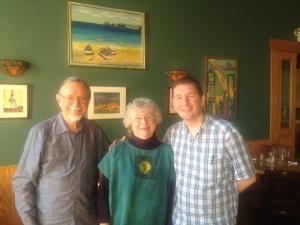Guiding participation and inclusion
We welcome yesterday’s launch of NHS England’s Guidance for Participation and Inclusion which begins to lay a foundation for transformational change.
The central challenge for participation and inclusion more generally is how can we promote citizen-led innovation that stays local, but over time proliferates?
 On Tuesday in Chicago, Cormac and John McKnight had lunch with Marion Thompson, the founder of La Leche League International. Both John and Cormac consider this one of the finest and most enduring examples of citizen-led health producing change there is. It also affords us a wonderful answer to the above question. It is an exemplar of what we can do to support people to share their healthfulness with each other.
On Tuesday in Chicago, Cormac and John McKnight had lunch with Marion Thompson, the founder of La Leche League International. Both John and Cormac consider this one of the finest and most enduring examples of citizen-led health producing change there is. It also affords us a wonderful answer to the above question. It is an exemplar of what we can do to support people to share their healthfulness with each other.
When Cormac asked Marion how they managed to grow from five women meeting – as a breast feeding support group in a Chicago neighbourhood in the 1950s – to a worldwide movement, she simply said “we kept everything ‘mother sized’, and did not fall into the trap of trying to go to scale. Local is everything.” Programmes scale, movements spread.
It was this small group of women who, chapter by chapter, focused on the value of breastfeeding, who promoted world-wide the principles and values of breastfeeding. She emphasised “we did not take on the ‘formula industry’, we just doggedly focused on what we were passionate about.” In other words on what is strong not what is wrong.
But, by doing so they did push back the all-consuming message of that industry; that argued formula was far superior to breast milk.
The question such initiatives pose for us in terms of participation is how can we help people discover that which is invisible yet abundant within and around them.
This initiative and others like it remind us that health resources are largely in our communities. Our challenge is to identify, connect and mobilise them. Participation and inclusion that only focuses on getting more people using more government run programmes, misses this point. And that is what is most significant about these guidelines. Firstly, they begin to point to the resourcefulness that’s already in our neighbourhoods – albeit hidden in plain view behind labels – as the key starting point.
Secondly, by citing ABCD they open the way to a conversation that goes beyond a focus on individuals to a discussion about the ‘collective’ nature of health.
So, this guidance signals a widespread acceptance across the healthcare systems of the importance of meaningful ‘participation’ both of individuals and communities and it usefully begins to share ideas, approaches and examples of how this could be achieved. We congratulate NHS England on its recognition of the need to develop more connected powerful communities and of the potential of the ABCD approach and therefore a belief that the answers lie in communities!
We are looking forward to working with NHS England and others to further develop a greater understanding of the principles and value of the ABCD approach.
In a final analysis, as Prof. John McKnight would say: ‘you can’t know what a community needs, until you first know what a community has.’
For further information:
If you would like to learn more about Nurture Development and the potential of ABCD to nurture connected, healthier and happier communities read our previous blogs and visit our website.
We will be launching a new Health and Wellbeing Prospectus very soon. If you would like to receive an electronic copy or talk to us about our work please email us at info@nurturedevelopment.org or tweet us at @NurtureDev.
